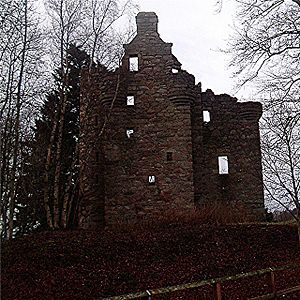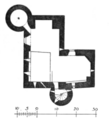Corse Castle facts for kids
Corse Castle is a ruined fortress located near Lumphanan in Aberdeenshire, Scotland. It stands by the Corse Burn, about 3 miles (4.8 km) north-west of Lumphanan. The castle you see today was built in the 16th century.
Contents
The Story of Corse Castle
Corse Castle belonged to the powerful Clan Forbes family for a long time. The original house on this spot was destroyed by bandits. Sir William Forbes, who owned the land at the time, decided to build a stronger home. He famously said, "Please God I will build me such a house as thieves will need to knock at ere they enter." This meant he wanted a castle so strong that thieves would have to knock on the door to get in, rather than just breaking in!
Sir William Forbes built the current castle in 1581. You can still see his initials and the date carved above the entrance.
Important People at Corse Castle
Sir William Forbes had seven sons. His eldest son, Patrick Forbes (born 1564), was born at the castle before it was rebuilt. Patrick became a very important person: the Bishop of Aberdeen in 1618. He served in this role until he passed away in 1635.
Another of William's sons, William, became a successful merchant. He bought and finished building the famous Craigievar Castle nearby in the 1620s. The third son, John, also joined the church. A younger son, Arthur, moved to Ireland and became a baronet (a special title).
Patrick Forbes's second son, John (1593–1648), inherited Corse Castle in 1635. He lived there until his death in 1648. After John, the castle passed to his son George, and then to his grandson. However, when there were no more direct heirs, Corse Castle went back to the Forbes family who owned Craigievar Castle.
Later Owners of Corse Castle
By 1869, James Ochoncar Forbes (1837—1900) lived at Corse Castle. He was the second son of Sir John Forbes, 7th Baronet of Craigievar. His older brother, William Forbes-Sempill, 17th Lord Sempill, had inherited Craigievar Castle.
In the mid-1800s, a new, more modern house was built nearby. This meant the old Corse Castle was no longer needed as a home. When James Ochoncar Forbes died in 1900, his son John Walter Forbes inherited the estate. After John died without children in 1912, his younger brother, Lieutenant Colonel James Ochoncar Forbes (1867—1945), took over. His son, Lieutenant Colonel Patrick Walter Forbes (1914—1979), also lived on the estate. Both father and son served as Deputy Lieutenants for Aberdeenshire.
What Corse Castle Looks Like
In a book from 1887 called The Castellated and Domestic Architecture of Scotland, David MacGibbon and Thomas Ross described the castle. They noted that the Corse Burn, a stream nearby, had been dammed up to create a lovely sheet of water south of the castle. They also mentioned that the date 1581 and William Forbes's initials were on the doorway.
Today, Historic Scotland describes Corse Castle as a "remarkable survival" of a 16th-century Scottish Z-plan castle. This means it has a main rectangular block with towers at opposite corners, making it look a bit like the letter 'Z' from above. It is a protected historic site, known as a scheduled ancient monument.
Images for kids



